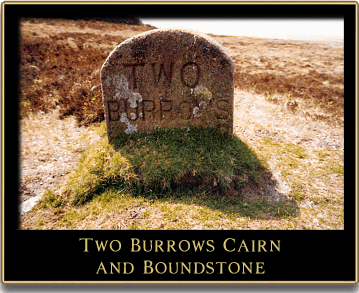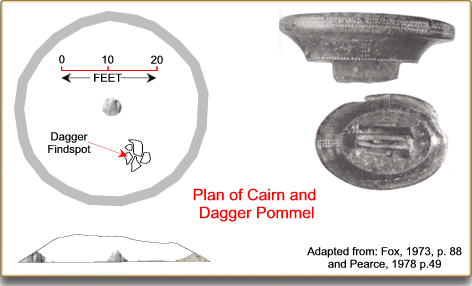
There are several Dartmoor legends which tell of fabulous hoards of gold hidden in the ancient Bronze Age cairns and kistvaens that dot the moor, indeed several of them have names which allude to such treasure; The Gold Box, The Crock of Gold, The Money Box and The Money Pit. But there is one cairn that did hide a priceless treasure which dated back to the time when prehistoric man was living on the moor. The huge ridge of Hameldon is studded along its length with at least seven Bronze Age cairns and almost in the centre of the hill is a cluster of two cairns which today are known as ‘Two Burrows’. Today the cairns are virtually covered with vegetation but luckily an old boundstone belonging to the manor of Natsworthy clearly states the place name as can be seen below

In 1872 Mr. C. Spence Bate, who was a dentist and a antiquarian from Plymouth was excavating the most northerly of the two cairns at Two Burrows when he found an amazing discovery. Back then the cairn was recorded as being about five feet high and around forty feet in length and unusually there was a paved area which lay approximately fifteen feet into the cairn. This paving consisted of five slabs which were centrally offset and under one of these he discovered an amount of burnt human bones and an oval piece of amber, (Starkey, 1984, p.105).
On closer inspection Spence Bate found that this artefact was the pommel of a dagger and further down he found the triangular, grooved bronze blade to which it belonged. On completion the finds were sent to Plymouth Museum for safe keeping but sadly in 1942 the building along with its contents was destroyed in an air raid on the city. Therefore today all that remains of the Hameldon Dagger are some photographs and a written description. which Pearce (1978, p.47) records thus:
‘Old records show that it measured 2.3 by 1.3 ins., cut from a single amber piece. The upper part was oval and the lower part fitted with a tang so that it could be fastened to the weapon’s hilt. More remarkable still, the amber surface was enhanced by the drilling of hundreds of tiny close holes set in a cruciform pattern on the upper surface into which were inserted pins of gold wire. A segment had been broken off the side and the piece repaired by the attachment of an amber piece with gold pins before it was deposited in the grave. The whole piece suggests a very high order of specialised craftsmanship.’
The style of decoration is by no means unique to Dartmoor as similar examples show this to be an Early Bronze Age technique that has been found in other examples in southern and central Europe. The pointillé method of studding has also been recognised in the bone and wooden hilts of daggers found in Wessex and Brittany, (Fox, 1973, p.87), both factors would suggest some form of inter-continental trade and communications between communities. It has been suggested that the dagger dates to around the Early Bronze Age period which, if it still survived today, would mean that it was about 5,000 years old.

There can be little doubt that whoever was interred in the grave would have been a person of high status if the value of the bronze dagger is anything to go by. As there is no naturally occurring amber on Dartmoor this may suggest one of two things, either the amber was brought to Devon where it was fashioned by a highly skilled, local craftsman or the completed dagger was imported as a trade item or gift.
Starkey, (1984, p106) picks up on one intriguing question related to the Hameldon Dagger and the surrounding landscape with its place-names. A mile and a half north west of Two Burrows is a hill known as Dagger Hill below which is an old tin mine which was called The Golden Dagger Mine. Nobody knows how old the name of Dagger Hill is but it is recorded that the Golden Dagger Mine was being, ‘actively developed in the period 1835 -60‘, (Hamilton Jenkin, 2005, p.57). This means the mine’s name was in use before the discovery of the dagger by Spence Bate in 1872, in which case what was the ‘Golden Dagger’ ? Could it have been that another such dagger had been discovered previously? Although Dagger Hill is now covered by the Soussons Plantation there are still several cairns and a cairn circle situated amongst the trees. Did someone excavate these cairns and find a tomb with grave goods which included a dagger and thereafter the hill was named after the discovery? One possible explanation of the ‘golden’ element in the mine’s name is noted by Richardson, (1993, p.18) when he states that in 1878 the then manager of the Golden Dagger mine reported that the remians of, ‘primitive gold-washing equipment‘, was found at the mine. This could indicate that at some stage of the mine’s history deposits of gold were either found or prospected for?
Despite the tragic loss of this artefact it still can be regarded as one of the most notable finds from the prehistoric period anywhere on Dartmoor. It also begs the question as to what else is still to be discovered and more importantly what else has been discovered but never reported?
Reference.
Fox, A. 1973. South West England, 3,500 – AD600. Newton Abbot: David & Charles.
Hamilton Jenkin, A. K. 2005. Mines of Devon. Ashbourne: Landmark Publishing Ltd.
Pearce, S. 1978. Devon in Prehistory, Exeter: Exeter City Museums.
Richardson, P. H. G. 1993. Mines of Dartmoor and the Tamar Valley. Sheffield: The Northern Mining Research Society.
Starkey, F. H. 1984. Odds and Ends From Dartmoor. Published privately.
 Legendary Dartmoor The many aspects past and present of Dartmoor
Legendary Dartmoor The many aspects past and present of Dartmoor

Thanks for a marvelous posting! I seriously
enjoyed reading it, you are a great author.I will remember to bookmark your blog and will often come back at some point.
I want to encourage one to continue your great work, have a nice evening!
Thanks for your kind comments, there’s plenty more of this on the website which I hope you will enjoy.